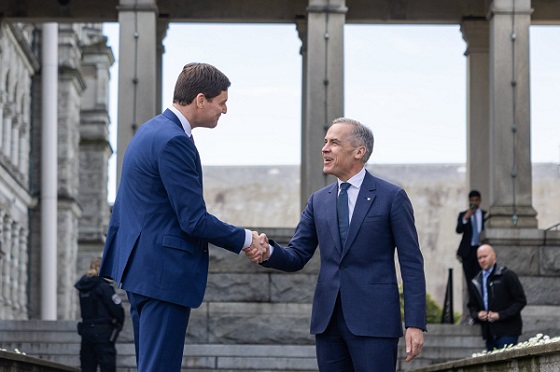Economy
Trump Could Bring Back “America First”. What Could Happen to Canada’s Natural Resource Exports?

From EnergyNow.ca
A second Trump presidency likely means more tariffs, and Canada’s energy and forestry sectors will feel the impact.
As the passing of former Prime Minister Brian Mulroney was reported, we thought back to his ratification of the North American Free Trade Agreement (NAFTA) with the United States and Mexico.
The question now is: If Donald Trump becomes the next President of the U.S., what happens to the U.S.-Mexico-Canada Agreement (USMCA) of 2020? The USMCA came after Trump threatened to pull out of NAFTA in 2018.
On Monday, the Supreme Court of the United States recently overturned a ruling from the Colorado Supreme Court that barred Trump from appearing on the ballot during the 2024 presidential election, clearing a major obstacle in his goal of once again winning the presidency in November.
If Trump does win again in November, stand by for round two of the “America First” campaign of his first term.
“After decades of the status quo, President Trump has made it clear that Americans will no longer take back seat to the rest of the world,” said Ken Farnaso, who was a deputy national press secretary during Trump’s ultimately unsuccessful 2020 re-election campaign.
So prepare, for starters, for a 10 percent tariff on imports into the U.S. — and Canada is the second largest source of those imports.
Trump’s promised tariffs would hammer Canadian exports to the U.S. In 2021 (the latest figures we see), those exports were worth $355 billion, including oil ($78.8 billion), automobiles ($26.4 billion), and natural gas ($13.4 billion).
What would Trump do about increased exports of Canadian oil to the U.S. through the Trans Mountain Expansion Project? What about our natural-gas exports, which have helped the U.S. become the world’s biggest exporter of liquefied natural gas (LNG)?
And a Trump presidency would undoubtedly mean more trouble for Canada’s forestry sector. It has long been fighting “entirely unwarranted,” U.S. tariffs on our softwood lumber — and now has been told that America will soon boost the border-crossing charges to 13.86 percent, up from 8.05 percent.
(Under the U.S. Tariff Act, the Department of Commerce determines whether goods are being sold at less than fair value or if they’re benefiting from subsidies provided by foreign governments. U.S. producers insist that provincial stumpage fees are so low as to amount to an unfair subsidy.)
And on foreign affairs, note Trump’s tough promise for China: tariffs of 60 percent or higher on imported Chinese goods. And, he has added, “Maybe it’s going to be more than that.”
This comes after the trade war he triggered during his first term as president when he imposed $250 billion in China tariffs. That disrupted the global economy, hammered consumers, and hit stock markets.
U.S. stock-market watchers have shuddered at this new promise. Nikki Haley, who suspended her campaign for the Republican nomination on Wednesday morning, has said: “What Donald Trump’s about to do, is he’s going to raise every (American) household’s expenses by $2,600 a year.”
Trump has said nothing about current U.S.-Canada relations, but has in the past declared:
- “We lose with Canada — big-league. Tremendous, tremendous trade deficits with Canada.”
- “Canada has been very difficult to deal with. . . . They’re very spoiled.”
-
“Canada, what they’ve done to our dairy farm workers, it’s a disgrace.”
Roland Paris, a Canada-based associate fellow of the U.S. and the Americas Program writes:
“ Canada is not the only country bracing for Donald Trump’s possible return to the White House – but few have more at stake.”
“Three-quarters of Canada’s goods exports, accounting for more than one-quarter of the country’s gross domestic product, go to the U.S. Given Trump’s impulsiveness and deeply protectionist instincts, Canada’s business and political leaders are understandably nervous.”
Prime Minister Justin Trudeau told business leaders in Montreal: “It wasn’t easy the first time, and if there is a second time, it won’t be easy either.”
Indeed. If the second time begins with Trump being elected on November 5, and sworn in on January 20, 2025, it could be a nasty case of “Oh, Canada.”
Alberta
Alberta’s grand bargain with Canada includes a new pipeline to Prince Rupert

From Resource Now
Alberta renews call for West Coast oil pipeline amid shifting federal, geopolitical dynamics.
Just six months ago, talk of resurrecting some version of the Northern Gateway pipeline would have been unthinkable. But with the election of Donald Trump in the U.S. and Mark Carney in Canada, it’s now thinkable.
In fact, Alberta Premier Danielle Smith seems to be making Northern Gateway 2.0 a top priority and a condition for Alberta staying within the Canadian confederation and supporting Mark Carney’s vision of making Canada an Energy superpower. Thanks to Donald Trump threatening Canadian sovereignty and its economy, there has been a noticeable zeitgeist shift in Canada. There is growing support for the idea of leveraging Canada’s natural resources and diversifying export markets to make it less vulnerable to an unpredictable southern neighbour.
“I think the world has changed dramatically since Donald Trump got elected in November,” Smith said at a keynote address Wednesday at the Global Energy Show Canada in Calgary. “I think that’s changed the national conversation.” Smith said she has been encouraged by the tack Carney has taken since being elected Prime Minister, and hopes to see real action from Ottawa in the coming months to address what Smith said is serious encumbrances to Alberta’s oil sector, including Bill C-69, an oil and gas emissions cap and a West Coast tanker oil ban. “I’m going to give him some time to work with us and I’m going to be optimistic,” Smith said. Removing the West Coast moratorium on oil tankers would be the first step needed to building a new oil pipeline line from Alberta to Prince Rupert. “We cannot build a pipeline to the west coast if there is a tanker ban,” Smith said. The next step would be getting First Nations on board. “Indigenous peoples have been shut out of the energy economy for generations, and we are now putting them at the heart of it,” Smith said.
Alberta currently produces about 4.3 million barrels of oil per day. Had the Northern Gateway, Keystone XL and Energy East pipelines been built, Alberta could now be producing and exporting an additional 2.5 million barrels of oil per day. The original Northern Gateway Pipeline — killed outright by the Justin Trudeau government — would have terminated in Kitimat. Smith is now talking about a pipeline that would terminate in Prince Rupert. This may obviate some of the concerns that Kitimat posed with oil tankers negotiating Douglas Channel, and their potential impacts on the marine environment.
One of the biggest hurdles to a pipeline to Prince Rupert may be B.C. Premier David Eby. The B.C. NDP government has a history of opposing oil pipelines with tooth and nail. Asked in a fireside chat by Peter Mansbridge how she would get around the B.C. problem, Smith confidently said: “I’ll convince David Eby.”
“I’m sensitive to the issues that were raised before,” she added. One of those concerns was emissions. But the Alberta government and oil industry has struck a grand bargain with Ottawa: pipelines for emissions abatement through carbon capture and storage.
The industry and government propose multi-billion investments in CCUS. The Pathways Alliance project alone represents an investment of $10 to $20 billion. Smith noted that there is no economic value in pumping CO2 underground. It only becomes economically viable if the tradeoff is greater production and export capacity for Alberta oil. “If you couple it with a million-barrel-per-day pipeline, well that allows you $20 billion worth of revenue year after year,” she said. “All of a sudden a $20 billion cost to have to decarbonize, it looks a lot more attractive when you have a new source of revenue.” When asked about the Prince Rupert pipeline proposal, Eby has responded that there is currently no proponent, and that it is therefore a bridge to cross when there is actually a proposal. “I think what I’ve heard Premier Eby say is that there is no project and no proponent,” Smith said. “Well, that’s my job. There will be soon. “We’re working very hard on being able to get industry players to realize this time may be different.” “We’re working on getting a proponent and route.”
At a number of sessions during the conference, Mansbridge has repeatedly asked speakers about the Alberta secession movement, and whether it might scare off investment capital. Alberta has been using the threat of secession as a threat if Ottawa does not address some of the province’s long-standing grievances. Smith said she hopes Carney takes it seriously. “I hope the prime minister doesn’t want to test it,” Smith said during a scrum with reporters. “I take it seriously. I have never seen separatist sentiment be as high as it is now. “I’ve also seen it dissipate when Ottawa addresses the concerns Alberta has.” She added that, if Carney wants a true nation-building project to fast-track, she can’t think of a better one than a new West Coast pipeline. “I can’t imagine that there will be another project on the national list that will generate as much revenue, as much GDP, as many high paying jobs as a bitumen pipeline to the coast.”
Business
Carney’s European pivot could quietly reshape Canada’s sovereignty

This article supplied by Troy Media.
Canadians must consider how closer EU ties could erode national control and economic sovereignty
As Prime Minister Mark Carney attempts to deepen Canada’s relationship with the European Union and other supranational institutions, Canadians should be asking a hard question: how much of our national independence are we prepared to give away? If you want a glimpse of what happens when a country loses control over its currency, trade and democratic accountability, you need only look to Bulgaria.
On June 8, 2025, thousands of Bulgarians took to the streets in front of the country’s National Bank. Their message was clear: they want to keep the lev and stop the forced adoption of the euro, scheduled for Jan. 1, 2026.
Bulgaria, a southeastern European country and EU member since 2007, is preparing to join the eurozone—a bloc of 20 countries that share the euro as a common currency. The move would bind Bulgaria to the economic decisions of the European Central Bank, replacing its national currency with one managed from Brussels and Frankfurt.
The protest movement is a vivid example of the tensions that arise when national identity collides with centralized policy-making. It was organized by Vazrazdane, a nationalist, eurosceptic political party that has gained support by opposing what it sees as the erosion of Bulgarian sovereignty through European integration. Similar demonstrations took place in cities across the country.
At the heart of the unrest is a call for democratic accountability. Vazrazdane leader Konstantin Kostadinov appealed directly to EU leaders, arguing that Bulgarians should not be forced into the eurozone without a public vote. He noted that in Italy, referendums on the euro were allowed with support from less than one per cent of citizens, while in Bulgaria, more than 10 per cent calling for a referendum have been ignored.
Protesters warned that abandoning the lev without a public vote would amount to a betrayal of democracy. “If there is no lev, there is no Bulgaria,” some chanted. For them, the lev is not just a currency: it is a symbol of national independence.
Their fears are not unfounded. Across the eurozone, several countries have experienced higher prices and reduced purchasing power after adopting the euro. The loss of domestic control over monetary policy has led to economic decisions being dictated from afar. Inflation, declining living standards and external dependency are real concerns.
Canada is not Bulgaria. But it is not immune to the same dynamics. Through trade agreements, regulatory convergence and global commitments, Canada has already surrendered meaningful control over its economy and borders. Canadians rarely debate these trade-offs publicly, and almost never vote on them directly.
Carney, a former central banker with deep ties to global finance, has made clear his intention to align more closely with the European Union on economic and security matters. While partnership is not inherently wrong, it must come with strong democratic oversight. Canadians should not allow fundamental shifts in sovereignty to be handed off quietly to international bodies or technocratic elites.
What’s happening in Bulgaria is not just about the euro—it’s about a people demanding the right to chart their own course. Canadians should take note. Sovereignty is not lost in one dramatic act. It erodes incrementally: through treaties we don’t read, agreements we don’t question, and decisions made without our consent.
If democracy and national control still matter to Canadians, they would do well to pay attention.
Isidoros Karderinis was born in Athens, Greece. He is a journalist, foreign press correspondent, economist, novelist and poet. He is accredited by the Greek Ministry of Foreign Affairs as a foreign press correspondent and has built a distinguished career in journalism and literature.
Troy Media empowers Canadian community news outlets by providing independent, insightful analysis and commentary. Our mission is to support local media in helping Canadians stay informed and engaged by delivering reliable content that strengthens community connections and deepens understanding across the country.
-

 Alberta2 days ago
Alberta2 days agoAlberta’s grand bargain with Canada includes a new pipeline to Prince Rupert
-

 Bruce Dowbiggin1 day ago
Bruce Dowbiggin1 day agoWOKE NBA Stars Seems Natural For CDN Advertisers. Why Won’t They Bite?
-

 Business2 days ago
Business2 days agoCarney’s European pivot could quietly reshape Canada’s sovereignty
-

 Health19 hours ago
Health19 hours agoLast day and last chance to win this dream home! Support the 2025 Red Deer Hospital Lottery before midnight!
-

 Crime10 hours ago
Crime10 hours agoUK finally admits clear evidence linking Pakistanis and child grooming gangs
-

 Business15 hours ago
Business15 hours agoCarney praises Trump’s world ‘leadership’ at G7 meeting in Canada
-

 Energy1 day ago
Energy1 day agoCould the G7 Summit in Alberta be a historic moment for Canadian energy?
-

 Crime1 day ago
Crime1 day agoMinnesota shooter arrested after 48-hour manhunt




